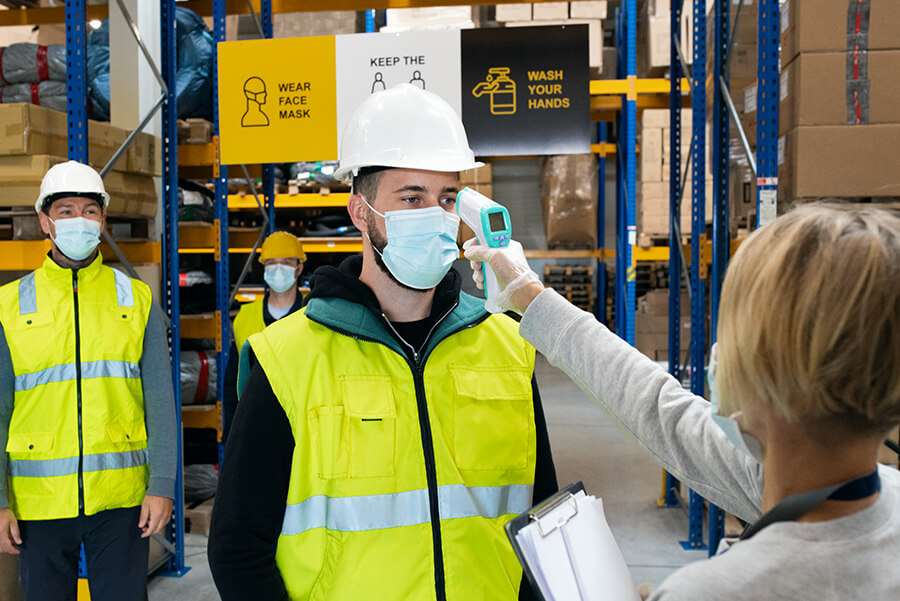
Priority for retail logistics during the coronavirus pandemic and medium to long-term actions
The Covid-19 pandemic is reshaping business. Several countries have been in lockdown for almost a month, and the most common scenes are empty streets and much of commerce and service providers closed. But there is one sector that has been working hard, perhaps even more than before. It is the retail of essential goods, such as food and medicine, which has intensified efforts to ensure the health and well-being of the population.
To accomplish this mission, its logistics operations are in full swing, facing a series of challenges to bring these items to supermarkets, pharmacies, or customers’ homes. To reduce difficulties, leaders of these companies have prioritized transparency, dialogue, joint analysis, and offering quick responses.
On the other hand, the retail of non-essential goods is trying to keep its activities by intensifying e-commerce operations. To boost sales, many of these companies offer exclusive benefits such as free shipping or discounts on purchases. The truth is that everyone, in their own way, is trying to readjust to the new scenario, developing specific strategies to overcome difficulties and keep the business active.
McKinsey & Company, a world leader in the business consulting market, has published several articles and analyses on the impacts of the crisis, the immediate reactions of companies, and how they should act. Regarding the response through the transformations underway, the company argues that businesses must think and act according to five horizons:
1) Resolve
Address the challenge that Covid-19 poses to the workforce, customers, and partners.
2) Resilience
Tackle new deadline management challenges and broader resilience issues.
3) Return
Create a detailed plan to quickly scale the business back up.
4) Reimagination
Reimagine the “next normal”: understand how change can have permanent impacts and how companies should reinvent themselves.
5) Reform
Be clear about how the environment in your sector might evolve (regulation, leadership role).
For McKinsey & Company, the most important thing is to establish a crisis committee. By bringing together top management in a unique and flexible structure, the company is better able to handle adverse situations, guiding everyone to understand, react, and improve promptly.
According to McKinsey & Company, in the supply chain, the crisis committee must cover several priorities, from executing sales and operations planning based on scenarios to product availability and supplier qualification. In all these activities, the committee acts as a single, authoritative source of information, point of contact, and decision-making place.
The crisis committee can also break down some boundaries between functions. For example, it can bring together logistics and purchasing managers to identify the most urgent transport contracts that require renegotiation to ensure alternative transport routes. And it can resolve questions about which production sites should be reactivated first – and to what extent – considering supply constraints. In short, it can be said that the primary function of the committee is to ensure that all impasses are resolved.
It is worth adding that the information gathered by the crisis committee will be crucial for analyzing the scenario so that the crisis is addressed with clear priorities.
Retail Actions
McKinsey & Company has also presented the main changes or specific challenges for the retail supply chain at this time of crisis. They are:
1) Relationship with suppliers
Due to the increasing demand for essential goods, retailers face shortages in the network. To combat this, they have worked closely with their suppliers.
For the most important products, daily meetings are organized with strategic suppliers to work with options to ensure an adequate supply of high-demand essential items. This is the top priority for companies in the food and pharmaceutical categories that must ensure quick and reliable supply.
Actions taken:
– Simplify SKU profiles to reduce variety and increase quantities;
– Negotiate payment terms for major suppliers;
– Extend delivery times with suppliers;
– “Relaxation” regarding OTIF (On Time In Full).
Merchandising Operations
As retailers need to “recalibrate” their orders to meet new customer demand, they will also need to make changes in purchasing, planning, and inventory management operations. For this, it is important that some actions are taken:
– Review purchasing plans that favor high-demand items;
– Direct stocks to locations where sales are active;
– Replace replenishment and stock allocation algorithms, considering new demands.
In the case of retailing non-essential goods, the following actions are recommended:
– Reduce long-term purchases to set aside cash;
– Anticipate future sales increases and adjust purchasing plans.
Distribution
For McKinsey & Company, this part of the supply chain is where the demand trends for essential and non-essential goods begin to overlap significantly. Among the actions suggested for the current scenario are:
– Reinstate or reallocate employees to increase capacity;
– Provide training to store and back-office staff to assist with e-commerce;
– Temporarily move offices to distribution centers;
– Implement significant routine changes to maintain workers’ health and safety, as well as improve retention and reduce turnover.
Logistics
As McKinsey & Company points out, more than ever, it is essential to maintain flexibility within logistics. For this, it is important to:
– Allocate more transportation capacity for high-demand items;
– Have suppliers deliver directly to stores;
– Stock products at points of sale located in strategic locations to supply smaller stores.
In the case of retailing non-essential goods, the following actions are recommended:
– Explore alternative and supplementary delivery options;
– Offer transportation if a private fleet is available to support the movement of critical goods.
Order Fulfillment
During this confinement period, essential goods companies (such as food and medicine) have seen a significant increase in online purchases and orders for the delivery of these goods. Given this scenario, McKinsey & Company suggests:
– “Relax” the next-day delivery requirement;
– Optimize routes and adjust more delivery times;
– Fulfill as many requests as possible.
For the retail of non-essential goods, it is recommended to:
– Expand delivery and return options to offer customers greater flexibility.
Recommended Medium-term Actions
McKinsey & Company’s guidance for companies in general – and this also applies to retail – is that, as the crisis subsides, they convert their crisis committee into a medium-term risk management process. The recommendation is: “convert daily firefighting into reliable risk management.”
The idea is to transform the temporary formation of the crisis committee into a more formal risk management process. According to McKinsey & Company, companies “can use the knowledge and lessons learned from their short-term actions to lay the foundation for building a more resilient logistics.”
Therefore, the ideal is to create a permanent risk management team, which will be responsible for assessing threats to the supply chain, through the collection of clear information. There should also be a regular interface with other functions, including sales and marketing, finance, human resources, research and development, and IT, to ensure and encourage high awareness of the importance and implications of proper risk management.
Future
Regarding long-term actions, McKinsey & Company argues that companies must have both the risk management team and improve logistics planning.
Risk management begins with a thorough analysis of production, seeking to reduce costs and risks and (where possible) obtain business benefits. For McKinsey & Company, it is essential that companies review their histories and simulate possible scenarios to face future uncertainties and adapt agilely to a crisis environment.
Once risks are identified, measured, and classified, companies can consider safeguard measures and mitigation options, such as purchasing additional tools or negotiating purchasing options with key suppliers. Careful application of these advanced analyses can also help companies identify qualified suppliers and transport networks to move supplies faster.
According to McKinsey & Company, increasing agility in supply chain planning, using digital tools, allows for rapid end-to-end logistics rescheduling. For the company, new technologies play a fundamental role, enabling real-time visibility of the logistics operation, thus ensuring better and faster decisions. Additionally: “early adopters of innovations are making their supply chain more resilient.”
Finally, McKinsey & Company emphasizes that while Covid-19 is a widespread crisis, it is not an isolated incident. Other events, such as international trade disputes or natural disasters, for example, affect today’s complex supply chains to varying degrees. Therefore, it is essential that companies act now to mitigate future risks.














